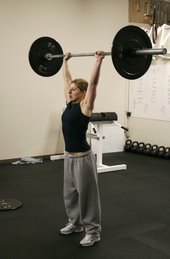"High frequency training results in faster muscle growth."
— Chad Waterbury
'Nothing could be worse in life than to be perfectly understood.' I can't remember who said it but I believe I stole it out of 'Quotable Quotes' in Reader's Digest and put it in my sister's yearbook because it seemed to sum things up rather nicely at the time. It applies here because yet again I'm pulling something out of Testosterone and frankly that clashes with all the pieces of me that eschew glossy, sexist gym publications. For the sake of clarity, I occasionally read Testosterone, I have an unexplained ability to bake fantastic cakes which satisfies my unhealthy fascination for frosting and I like dressing like a girl. There, now can we move on?
Specificity. I say it all the time and only partly because it just rolls off the tongue nicely. I say it over and over again because it's a simple way to sum up a huge concept. In order for your body to adapt to any specific stimulus, it must first be exposed to that stimulus. Sounds simple until you see basketball players trying to improve vertical leap on the calf raise machine (if they'd only use it as an obstacle to leap over they'd be on to something).
CrossFit is a varied stimulus therefore your specific adaptation is to chaos. Very liberating, don't you think? Can you imagine yard work or carrying boxes to a moving van in the framework of 3 sets of 12 reps at limited ranges of motion? On the plus side, once you fade out on the 13th box or fail to get it off the floor, nobody you know will ask you to help them move again.
Most of my clients get this right away but, this being a gym and all, I'm inevitably asked the question, "yes, but can I build muscles training like that?" Mr. Olympia muscles, no. That requires supplementation with, uh, 'Vitamin S'. But a real human physique with muscles, yes. Here's Chad Waterbury, again from Testosterone with his perspective:
It's a travesty we don't have more science focusing on muscle growth in humans. I can't blame the National Institute of Health (NIH), though. After all, given the plethora of life-threatening diseases that can surface or invade our bodies, it's probably better that funds be directed toward more humane endeavors. But damn, I sure wish we had more than rats, cats, and cows to demonstrate what's possible in terms of human muscle growth.
But all is not lost. The fact that the vast majority of hypertrophy-focused studies employed four-legged creatures only makes us coaches think a wee bit harder with regard to faster ways to build muscle.
Indeed, people like me are blessed with many clients from all walks of life that have become my "lab rats." And let me tell ya, I think I'm stumbling onto something big — something that no NIH study has effectively tackled, or will tackle, in the near future.
What is this "something big," you ask? It's High Frequency Training (HFT). What I mean by HFT is a system where muscle groups are trained more than four times per week. If fatigue and volume are managed — and that's specific to each person — no method will build muscle faster.
It's been said that science is the act of observing the world around us. And if we follow this example we'll see that the world around us is slapping us in the face with many powerful muscle-building demonstrations. For those who train a muscle group with enough intensity and frequency, hypertrophy always occurs faster than traditional bodybuilding methods.
I've had clients fail to make substantial gains with 10x3, 5x5, triple drop sets, and virtually every other method you can name. But in my world, one thing's for certain: I've never failed to build a person's muscles faster than ever if he follows my HFT methods to the letter.
A simpleton is constrained to the general postulates that were devised by non-training scientists. Specifically, these scientists have attempted to qualify muscle breakdown, fatigue, and recovery by postulating that after a muscle group is trained, performance drops (fatigue sets in), and muscle growth only occurs after a period of recovery and subsequent supercompensation. But what happens if you re-train a muscle group before it's recovered?
What if you performed 1000 calf raises every day for the next month? At the end of the month, do you think your calves would be bigger or smaller? Listen, no scientist on earth would argue that the human body is an organism that adapts to the demand that's placed on it. This is known as Specific Adaptation to Imposed Demand — the SAID principle.
When you starve yourself, your metabolism slows. When you overfeed yourself, your metabolism increases. When you're dehydrated, you hold more water. When you're over-hydrated, your body releases water. When you practice Chopin on the piano, your nervous system builds neural connections that enhance finger control. If you don't practice piano, your nervous system doesn't build those neural connections because there's no reason to.
So when you train muscles frequently, your body must adapt to the imposed demand. What we currently know is that a muscle group becomes more neurologically efficient and grows bigger with training. These processes occur because the nervous system enhances those motor pathways, and new proteins are inserted into the muscles.
What I can't do is reference a human-based, hypertrophy-focused study that incorporates the type of training that I'm talking about. But what I can do is tell you to look at the delts of boxers, the thighs of speed skaters, and the lats of swimmers.
Sure, I can't prove that training with a high frequency results in the faster muscle growth because the NIH doesn't prioritize such information. But I can tell you to observe the world around you. After all, that's what science is all about.
— CW
skip to main |
skip to sidebar








A conversation with my clients about exercises, work-outs and nutrition
Search This Blog

About Me
- Heather
- I'm an NSCA-PT and CrossFit certified personal trainer with nine years experience. I hold a purple belt in Brazilian Jiu Jitsu under Marcelo Alonso and Ben Blackstone and I am a Karnataka State Gold Medalist in Weightlifting.

Books
Brain Rules: 12 Principles for Surviving and Thriving at Work, Home, and School Food Politics: How the Food Industry Influences Nutrition, and Health, Revised and Expanded Edition (California Studies in Food and Culture)
Food Politics: How the Food Industry Influences Nutrition, and Health, Revised and Expanded Edition (California Studies in Food and Culture) Good Calories, Bad Calories: Fats, Carbs, and the Controversial Science of Diet and Health (Vintage)
Good Calories, Bad Calories: Fats, Carbs, and the Controversial Science of Diet and Health (Vintage) The Omnivore's Dilemma: A Natural History of Four Meals
The Omnivore's Dilemma: A Natural History of Four Meals Practical Programming for Strength Training
Practical Programming for Strength Training PROTEIN POWER
PROTEIN POWER Secrets of the Soil : New Solutions for Restoring Our Planet
Secrets of the Soil : New Solutions for Restoring Our Planet Starting Strength (2nd edition)
Starting Strength (2nd edition) The Brain Trust Program: A Scientifically Based Three-Part Plan to Improve Memory, Elevate Mood, Enhance Attention, Alleviate Migraine and Menopausal Symptoms, and Boost Mental Energy
The Brain Trust Program: A Scientifically Based Three-Part Plan to Improve Memory, Elevate Mood, Enhance Attention, Alleviate Migraine and Menopausal Symptoms, and Boost Mental Energy Fiber Menace: The Truth About the Leading Role of Fiber in Diet Failure, Constipation, Hemorrhoids, Irritable Bowel Syndrome, Ulcerative Colitis, Crohn's Disease, and Colon Cancer
Fiber Menace: The Truth About the Leading Role of Fiber in Diet Failure, Constipation, Hemorrhoids, Irritable Bowel Syndrome, Ulcerative Colitis, Crohn's Disease, and Colon Cancer The Revolution Will Not Be Microwaved: Inside America's Underground Food Movements
The Revolution Will Not Be Microwaved: Inside America's Underground Food Movements The Zone: A Dietary Road Map to Lose Weight Permanently : Reset Your Genetic Code : Prevent Disease : Achieve Maximum Physical Performance
The Zone: A Dietary Road Map to Lose Weight Permanently : Reset Your Genetic Code : Prevent Disease : Achieve Maximum Physical Performance Twinkie, Deconstructed: My Journey to Discover How the Ingredients Found in Processed Foods Are Grown, Mined (Yes, Mined), and Manipulated into What America Eats
Twinkie, Deconstructed: My Journey to Discover How the Ingredients Found in Processed Foods Are Grown, Mined (Yes, Mined), and Manipulated into What America Eats Mind the Gap: The Science Behind the Sporting Mind
Mind the Gap: The Science Behind the Sporting Mind Extraordinary Knowing: Science, Skepticism, and the Inexplicable Powers of the Human Mind
Extraordinary Knowing: Science, Skepticism, and the Inexplicable Powers of the Human Mind The Subtle Body: An Encyclopedia of Your Energetic Anatomy
The Subtle Body: An Encyclopedia of Your Energetic Anatomy Stumbling on Happiness
Stumbling on Happiness
Products

Blog Archive
-
▼
2007
(87)
-
▼
January
(18)
- Slow Burn
- That's what he SAID
- Logical Leaps
- Why not eat better food?
- Combat Ready
- Breaking copyright laws . . .
- You'd only have to goo . . . . msn search . . .
- Today's tip comes from Dan John:Goals vs. Behavior...
- Stealth abs
- "Cardio" Conundrum
- 300
- The Need for Speed
- A serving of self-control
- Flunking P.E.
- Inspired by 'Angie'
- A strong structure in the raw
- Sneaky Snacking
- A Fat Chance
-
▼
January
(18)

Resources
- Art DeVany
- Brain Health
- Buy Kettlebells
- CrossFit Eastside
- CrossFit Main Page
- Dr. Cordain's Research
- Dr. Eades
- Dr. Ladd Carlston
- Dr. Randip Singh
- Environmental Working Group
- Food, Farming & Healing Arts
- Get Up! Newsletter
- Health Geek's Wikipedia
- Homework for 10a Class
- Jennifer Adler M.S., C.N.
- Marcelo Alonso BJJ
- Michael Pollan
- O'Lifting Coach Mike Burgener
- Predictably Irrational
- Robb Wolf
- TED: Ideas Worth Spreading
- THIS IS THE PREFERRED MEAL TRACKER
- Tim Ferriss, 4 Hour Work Week


